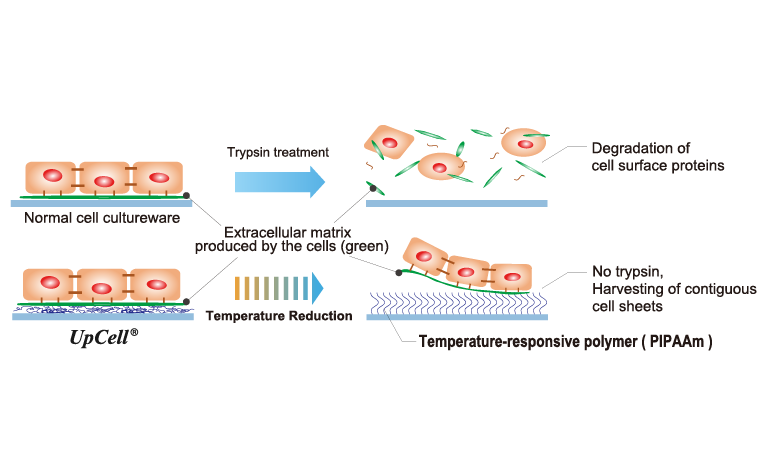Nano-Bio Interface
A surface coated with a temperature-responsive polymer immobilized at nanometer-scale thickness
-
The UpCell® surface consists of a layer of poly(N-isopropylacrylamide) (PIPAAm) uniformly immobilized at nanometer-scale thickness. Via precision immobilization of PIPAAm to the cultureware surface, CellSeed has transformed a phase transition behavior that takes place at the lower critical solution temperature (LCST), a characteristic of the polymer itself, into a change in the properties of the cultureware surface. When cells are cultured on the immobilized PIPAAm, the polymer does not separate from the cultureware surface when the cells are detached. The precision immobilization of such a polymer to a cultureware surface has been enabled for the first time by the use of electron beam deposition.
-

Mechanism of the nano-bio interface
PIPAAm is a polymer with LCST of 32℃, and at temperatures above 32℃ in water, the polymer chains aggregate and separate from the water molecules, and at temperatures below 32℃, the polymer binds to water molecules and dissolves. When this polymer is immobilized at nanoscale thickness to a cultureware surface, the polymer chains in contact with water* at a temperature above 32℃ also aggregate similarly, and the properties of the surface PIPAAm polymer chains themselves are enhanced. By contrast, when the surface comes into contact with water* at a temperature below 32℃, the polymer chains on the surface are hydrated with water molecules and displays hydrophilicity, in contrast to the situation when the surface temperature is above 32℃. Typically, cells are readily attached to an appropriate hydrophobic surface and do not attach to hydrophilic surfaces. Uniformly immobilizing a nanoscale-thickness layer of PIPAAm provides an appropriate hydrophobic surface that behaves in the same manner as typical cultureware during incubation at the usual temperature of 37℃, and only when the temperature is below 32℃ does the surface become hydrophilic, to which cultured cells cannot adhere.
* A similar phenomenon occurs in when used as a medium for culturing cells.
The nano-bio interface that serves as the platform for cell sheet engineering
Using this nano-bio interface, it is now possible to detach cultured cells simply by altering the temperature, rather than by the conventional method using proteolytic enzymes. Because cultured cells are not treated enzymatically, cultured cells can be obtained in single sheets, rather than with the intercellular adhesion proteins being destroyed. As well, because the adhesion proteins formed between the cells and cultureware surface are preserved, the cell sheets graft readily to biological tissue, and it is also possible to stack multiple cell sheet layers together. Moreover, those cell sheets are maintained without destruction of the cell's essential functions by enzymatic treatment. The nano-bio interface is the platform technology that is essential for cell sheet engineering.
Deployment to various labware surfaces
Such a nano-bio interface was successfully achieved for the first time via our surface design technology. Through deployment of this technology, we have developed other products such as RepCell®, a range of cultureware used for cell collection, HydroCell®, which has a surface which repels cells completely, and Aqua Way® a chromatography base material for separation and purification processes.
FAQ
You can view frequently asked questions and answers regarding our business, including cell sheets.
